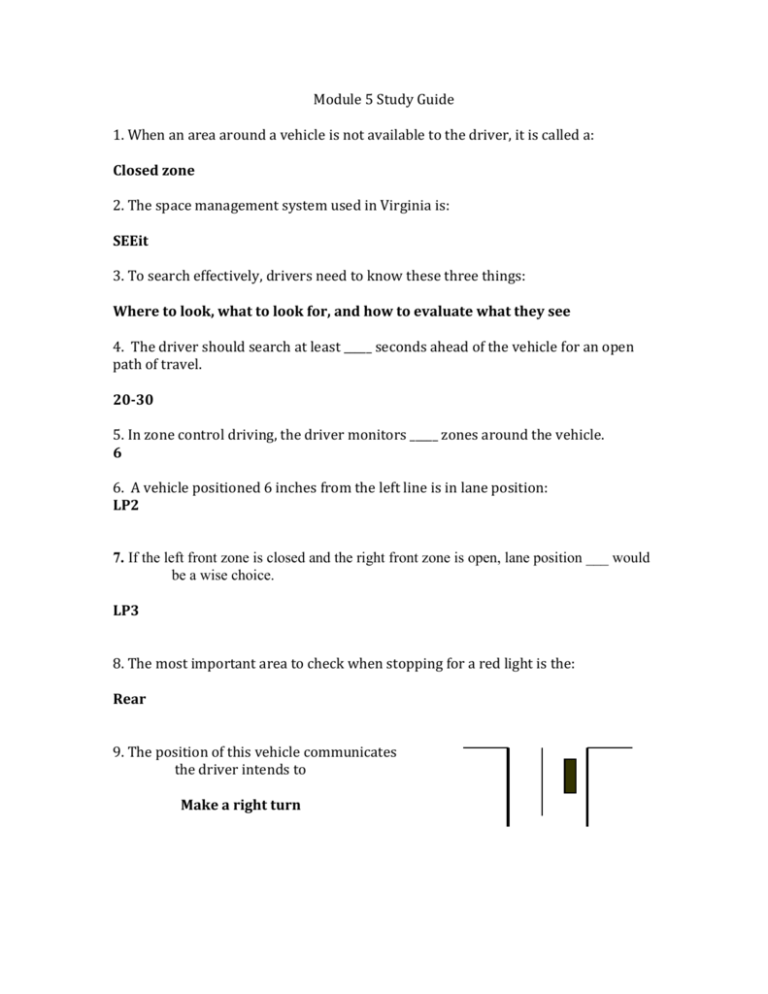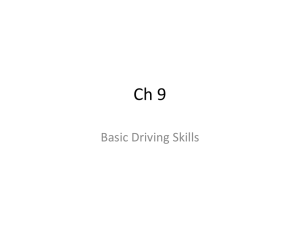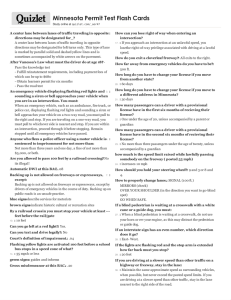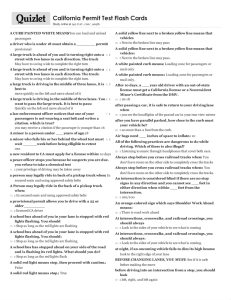Module 5 Study Guide answers
advertisement

Module 5 Study Guide 1. When an area around a vehicle is not available to the driver, it is called a: Closed zone 2. The space management system used in Virginia is: SEEit 3. To search effectively, drivers need to know these three things: Where to look, what to look for, and how to evaluate what they see 4. The driver should search at least _____ seconds ahead of the vehicle for an open path of travel. 20-30 5. In zone control driving, the driver monitors _____ zones around the vehicle. 6 6. A vehicle positioned 6 inches from the left line is in lane position: LP2 7. If the left front zone is closed and the right front zone is open, lane position ___ would be a wise choice. LP3 8. The most important area to check when stopping for a red light is the: Rear 9. The position of this vehicle communicates the driver intends to Make a right turn 10. A red traffic light is an example of: Closed zone 11. To cross a two lane roadway at 30 mph takes a gap of about: ½ block 12. To safely turn right and merge into traffic moving 55 mph, you will need a gap equal to about: 11 seconds 13. When stopped in traffic behind another vehicle, the driver should be able to see this: The rear tires of the vehicle in front of them 14. You should not drive more than _____ feet in a shared left turn lane. 200 feet 15. Once you have reached the apex of a curve, you should Lightly accelerate 16. Most crashes occur here: Intersections 17. Before entering an intersection you should do these three things: Count to 3 to allow intersection to clear, check for turning traffic, and identify an open zone 18. When approaching the crest of a hill, lane position _____ is recommended. LP3 19. Excessive steering input in a curve may result in: An understeer or oversteer skid 20 A vehicle traveling 40 mph will take about _______ to pass another vehicle traveling 30 mph. 13 seconds 21. When passing another vehicle on a two lane roadway, what two things must you take into account? Think about speed and your position after your pass. What the speed limit is and when can I safely get back over 22. A vehicle traveling 40 mph, is going approximately how many feet per second? 60 feet per second 23. Where is passing illegal? Hills, curves, solid lines, railroad crossings, intersections, etc. 24. To safely pass another vehicle, start from a position _____ seconds back. 2 seconds (car) 4 seconds(tractor trailer) 25. A driver may pass a vehicle on the right in what cases? Slow moving vehicle, blocked lane, on a multi-lane highway 26. If you are traveling 50 mph and an oncoming vehicle is approaching at 50 mph, your closing rate is: 100 mph and 150 feet per second 27. A vehicle with its headlights off during daylight may not be visible until it is within _____ feet. 2500 feet 28. When is it legal to pass a stopped school bus? When there is a median or barrier between you and the school bus 29. How does a shared left turn lane help you when you are pulling out of a driveway or roadway? You can pull into the shared left turn lane and wait for traffic to clear, then you can turn left into your destination. 30. You are a defensive driver. What would you do before you come to a complete stop? Tap your brakes 31. Before turning right on red, a driver must do these three things: Stop, yield to pedestrians, yield to traffic turning left 32. What is stopping distance? Is it the same as braking distance? What scenarios would increase your stopping distance? The distance required to stop safely which includes your reaction. It is not the same as braking distance. Wet roads will increase your stopping distance. 33. What are staggered stop lines? What two purposes do they serve? The white stop lines that are sometimes at stop lights and intersections. They allow for a wider turning radius and increase visibility. 34. You are driving the gray vehicle. The black vehicle suddenly begins braking. Your best response is to Brake and move to lane position 5











